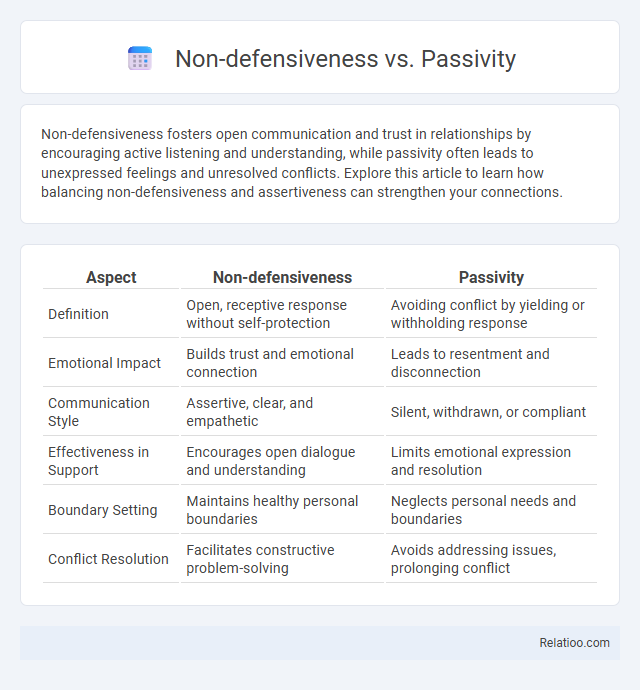Non-defensiveness fosters open communication and trust in relationships by encouraging active listening and understanding, while passivity often leads to unexpressed feelings and unresolved conflicts. Explore this article to learn how balancing non-defensiveness and assertiveness can strengthen your connections.
Table of Comparison
| Aspect | Non-defensiveness | Passivity |
|---|---|---|
| Definition | Open, receptive response without self-protection | Avoiding conflict by yielding or withholding response |
| Emotional Impact | Builds trust and emotional connection | Leads to resentment and disconnection |
| Communication Style | Assertive, clear, and empathetic | Silent, withdrawn, or compliant |
| Effectiveness in Support | Encourages open dialogue and understanding | Limits emotional expression and resolution |
| Boundary Setting | Maintains healthy personal boundaries | Neglects personal needs and boundaries |
| Conflict Resolution | Facilitates constructive problem-solving | Avoids addressing issues, prolonging conflict |
Understanding Non-Defensiveness: Core Concepts
Non-defensiveness involves maintaining openness and receptivity to feedback without reacting with aggression or avoidance, allowing for constructive dialogue and personal growth. It contrasts with passivity, where individuals may avoid addressing issues altogether, leading to unmanaged conflict and unresolved problems. Understanding non-defensiveness requires recognizing emotional regulation, active listening, and the willingness to engage in meaningful communication without perceived threat or resistance.
Defining Passivity in Communication
Passivity in communication involves avoiding expressing opinions, needs, or feelings, often yielding to others to prevent conflict. It differs from non-defensiveness, which emphasizes open, honest dialogue without reactive self-protection, and from defensiveness, where individuals protect themselves by counterattacking or withholding information. Understanding passivity helps identify communication patterns that hinder assertiveness and effective interpersonal interaction.
Key Differences Between Non-Defensiveness and Passivity
Non-defensiveness involves calmly acknowledging feedback or criticism without emotional resistance, fostering open communication and growth. Passivity, by contrast, is characterized by a lack of assertion or response, often leading to suppressed emotions and unmet needs. The key difference lies in engagement: non-defensiveness actively processes input and maintains self-respect, whereas passivity abdicates personal boundaries and voice.
The Psychological Roots of Defensive and Passive Behaviors
Defensive behaviors often stem from underlying fears of judgment or vulnerability, triggering a protective response to perceived threats, while passivity typically arises from feelings of helplessness or low self-esteem, leading individuals to avoid confrontation. Both defensive and passive reactions are rooted in psychological mechanisms aimed at self-preservation but manifest differently based on emotional regulation and past experiences. Understanding these psychological roots helps in distinguishing between assertive communication and maladaptive coping strategies in interpersonal dynamics.
Impact of Non-Defensiveness on Relationships
Non-defensiveness fosters open communication by allowing you to listen and respond thoughtfully without immediately reacting to perceived criticism, which strengthens trust and emotional intimacy in relationships. Passivity, in contrast, often leads to unresolved conflicts and resentment as needs and boundaries are neglected or ignored. Embracing non-defensiveness promotes healthier interactions, reduces misunderstandings, and cultivates a supportive environment where both parties feel heard and respected.
How Passivity Affects Personal and Professional Growth
Passivity often leads to missed opportunities for assertive communication and decision-making, hindering both personal and professional growth by fostering complacency and reducing problem-solving skills. In contrast, non-defensiveness encourages openness to feedback and promotes continuous learning, essential for effective leadership and relationship building. Understanding the distinction between passivity and non-defensiveness helps individuals develop resilience and adaptability, critical factors for achieving success and growth.
Recognizing Signs of Non-Defensive Communication
Recognizing signs of non-defensive communication involves observing openness to feedback, calm responses to criticism, and an ability to maintain constructive dialogue without escalation. Unlike passivity, which may exhibit avoidance or withdrawal from conflict, non-defensiveness demonstrates active engagement and thoughtful consideration of differing viewpoints. Key indicators include maintaining eye contact, acknowledging others' perspectives, and responding with clarity rather than defensiveness or silence.
Common Misconceptions About Being Non-Defensive
Non-defensiveness is often mistaken for passivity or avoidance, but it actually involves maintaining composure while actively engaging with criticism without emotional reactivity. Common misconceptions include believing that being non-defensive means agreeing with all feedback or not expressing one's perspective, which can lead to misunderstandings about assertiveness. True non-defensiveness balances openness to feedback with clear communication, avoiding both defensive resistance and passive submission.
Practical Strategies to Cultivate Non-Defensive Responses
Non-defensiveness involves acknowledging feedback without automatic resistance, while passivity often means avoiding confrontation or failing to assert your own needs. Practical strategies to cultivate non-defensive responses include active listening, pausing before reacting, and reframing criticism as an opportunity for growth. Your ability to separate emotional reactions from the content of feedback enhances communication and fosters personal development.
Balancing Assertiveness: Moving Beyond Passivity and Defensiveness
Balancing assertiveness requires distinguishing between non-defensiveness, passivity, and defensive behaviors to communicate effectively. Non-defensiveness involves openness to feedback without aggressive resistance, while passivity often leads to unexpressed needs and unresolved conflicts. Developing assertiveness empowers individuals to express thoughts confidently and respectfully, fostering healthier relationships and productive dialogue.

Infographic: Non-defensiveness vs Passivity
 relatioo.com
relatioo.com